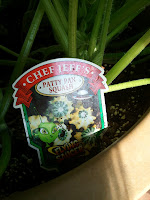From the tag: FLYING SAUCERThis summer squash looks just like its name – a flying saucer! The fun, star-like shape with radiating points and multi-color pattern is irresistible to kids. It has a semi-bush growth habit and is amoung the easiest vegetables to grow. This summer squash offers a creamy, buttery texture that I find mixes well with tomatoes, onions, mushrooms, cheeses and fresh herbs. Pick the fruits when they are about 2” in diameter and prepare like any summer squash: steam, bake roast, stuff, sauté or grill.
The patty pan squash are growing well without much more than daily watering and liquid fertilzer every 2 weeks. I check on my baby patty pans daily to see how they are coming. There are many blossoms and a number of small squash that have appeared in the last 2 weeks.
I will update as they grow larger.










